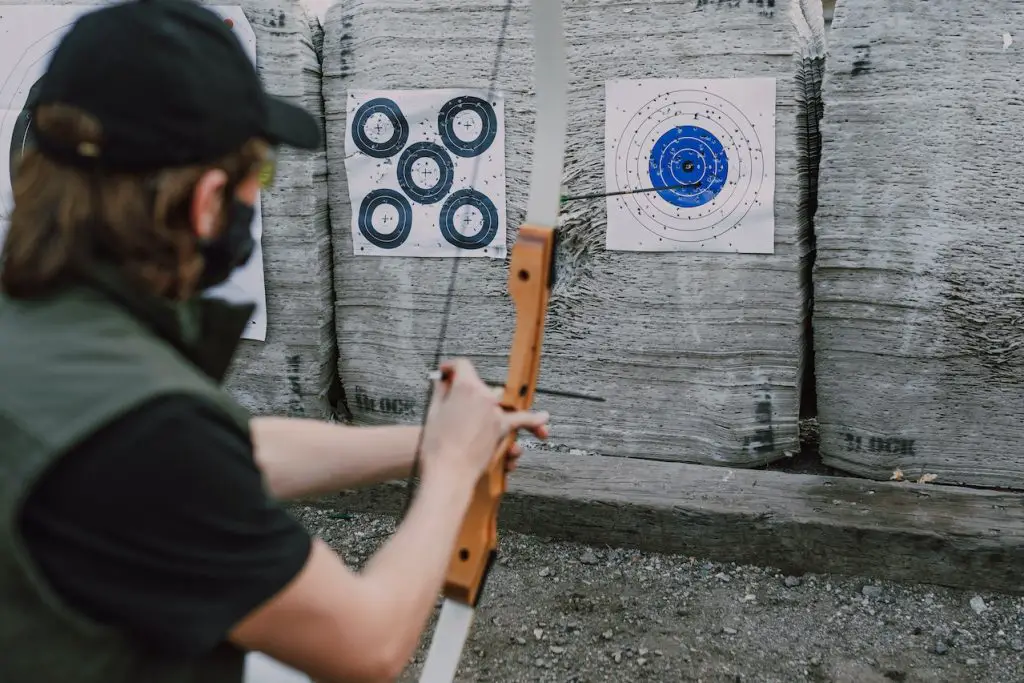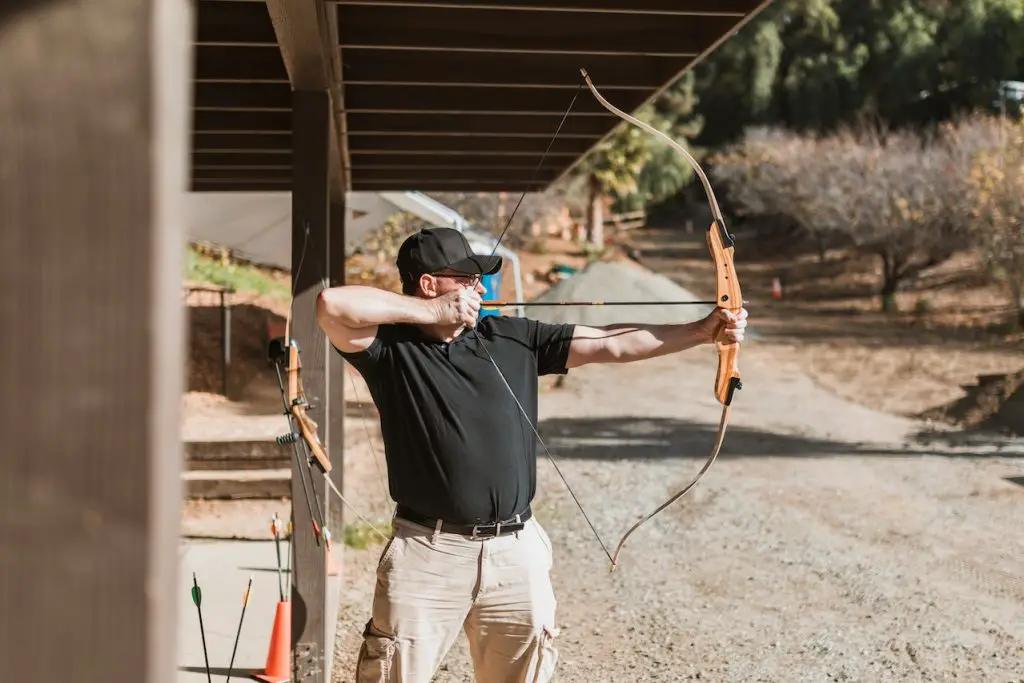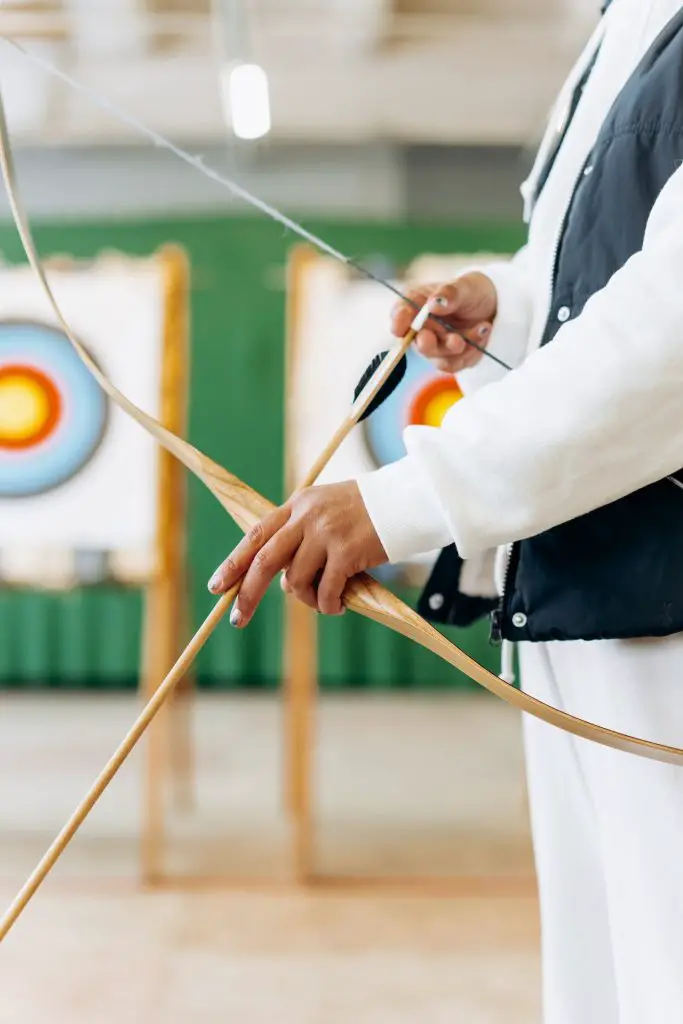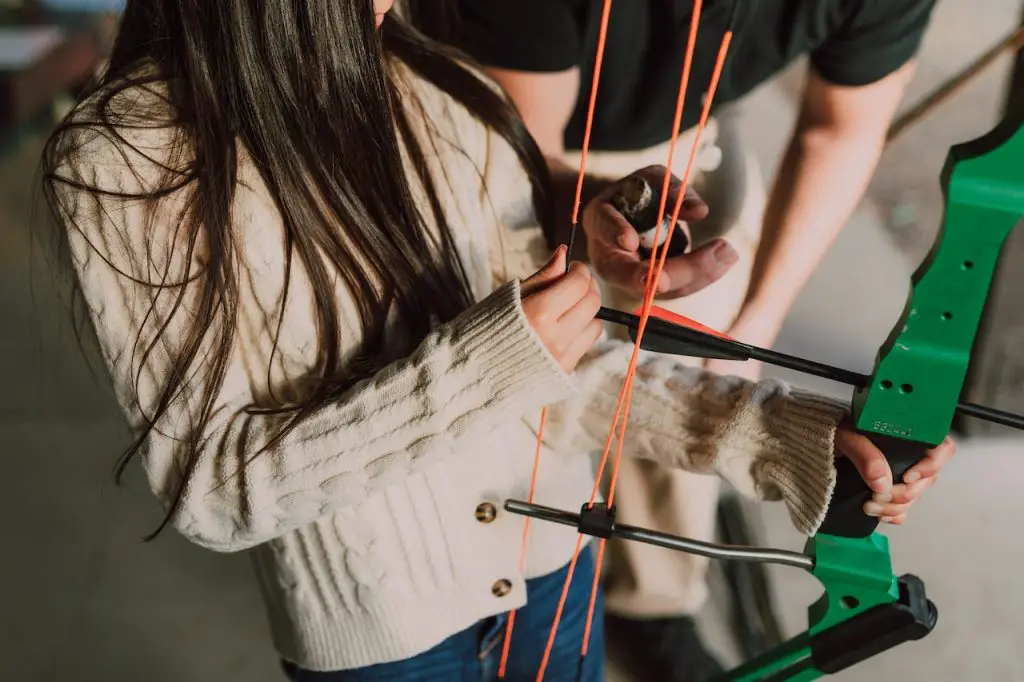Can You leave a Recurve Bow Strung?
A recurve bow is a popular type of bow used for hunting, archery competitions, and recreational shooting.
It has a unique design with limbs that curve away from the archer when the bow is unstrung, and a string that connects the two limbs.
The string is usually made of high-tensile material like Dacron or Fast Flight and is an essential component of the bow as it stores the energy that is released when the bow is fired.
The importance of proper care and maintenance for recurve bows cannot be overstated.

One question that often arises among archers is whether it is safe to leave a recurve bow strung for an extended period of time, or if it should be unstrung after each use.
In this article, we will explore the topic of leaving a recurve bow strung.
We will discuss the anatomy of recurve bows, the risks of leaving a bow strung, the benefits of unstringing a bow, and the exceptions to unstringing. We will also provide guidance on how to safely unstring a recurve bow.
Quick Answer: It is advisable to unstring your wooden bow after every session, but only if you do not plan to use it for the next week. This practice can help extend the lifespan of your bow. However, it is essential to be cautious of frequent unstringing as it may also cause damage to the bow.
It is important to note that the information provided in this article is general in nature, and may not apply to all types of recurve bows. You should consult the manufacturer’s instructions or seek advice from a professional before making any decisions regarding the care and maintenance of your recurve bow.
With that said, let us dive into the topic of leaving a recurve bow strung.
Understanding Recurve Bows
A. The Anatomy of a Recurve Bow
To understand the risks and benefits of leaving a recurve bow strung, it is essential to understand the anatomy of the bow.
A recurve bow has several key components, including the grip, the limbs, the bowstring, and the string nocks.
The limbs are the curved sections of the bow that store and release energy when the bow is fired.
The string nocks are the notches at the end of each limb where the bowstring is attached. The grip is the central portion of the bow that the archer holds onto while shooting.
B. The Importance of Proper Stringing
One of the most critical aspects of caring for a recurve bow is proper stringing.
When stringing a recurve bow, it is essential to follow the manufacturer’s instructions carefully. Failure to do so can result in damage to the bow, or even injury to the archer.
Improper stringing can cause the limbs to twist or warp, compromising the bow’s performance and potentially rendering it unsafe to use.
The Risks of Leaving a Recurve Bow Strung
A. Increased Risk of Bow Damage
Leaving a recurve bow strung for an extended period can increase the risk of damage to the bow.
As previously mentioned, the weight of the bowstring can cause the limbs to warp or twist, affecting the bow’s accuracy and potentially causing it to fail during use.
Over time, the constant tension of the string can also cause the bowstring to stretch or fray, which can lead to reduced performance and increased risk of breakage.
It is advisable to unstring homemade self-wooden bows at the end of each day. On the other hand, modern laminated bows can be kept strung for an entire season without incurring any damage. It is crucial to keep the bows away from hot areas such as garages and cars to maintain their condition.
B. Potential Injury to Archers
If the bowstring becomes damaged or worn while the bow is left strung, it may snap while the archer is using the bow, potentially causing serious injury.
This risk is particularly high if the archer is using a high-draw weight bow, as the force of the bowstring can be significant.
In addition, if the bowstring is not properly maintained, it may become weakened or frayed, increasing the risk of breakage.
C. Decreased Bow Performance
Leaving a recurve bow strung for an extended period can also decrease the bow’s performance. Over time, the constant tension of the bowstring can cause it

Benefits of Unstringing a Recurve Bow
While there are risks associated with leaving a recurve bow strung, there are also benefits to unstringing the bow after each use.
A. Increased Bow Lifespan
Leaving a bow strung for an extended period can have detrimental effects on its lifespan.
When a bow is strung, the limbs are under pressure, which causes them to bend and store energy. This tension on the limbs is what allows the bow to shoot arrows with speed and accuracy.
However, when a bow is left strung for too long, the tension on the limbs becomes permanent, causing them to become weaker and less responsive over time.
Over time, the constant tension can cause the limbs to develop small cracks and fractures, which weaken the bow’s overall structure.
Additionally, the bowstring can also become stretched out or lose its elasticity, leading to decreased performance and accuracy.
Furthermore, temperature and humidity can exacerbate these issues.
For example, high temperatures can cause the bow to lose its shape or even warp, while moisture can cause the wood to swell or rot.
These factors can cause irreversible damage to the bow, shortening its lifespan significantly.
By unstringing your bow after each use, you can help alleviate these issues and prolong the lifespan of your bow.
Unstringing the bow allows the limbs to relax and release the tension, reducing the likelihood of damage or wear and tear. This practice can help ensure that your bow remains in good condition and provides optimal performance for years to come.
B. Reduced Risk of Injury
Unstringing your recurve bow after each use can also reduce the risk of injury to both the archer and the bow.
When the bow is unstrung, there is no tension on the limbs, which reduces the risk of warping, twisting, or breakage. In addition, an unstrung bow is less likely to accidentally discharge and cause injury.
C. Improved Bow Performance
Unstringing your recurve bow after each use can also help improve its performance.
When the bow is unstrung, the limbs can relax and return to their original shape, which can improve accuracy and consistency when shooting.
Unstringing the bow can also help prevent the bowstring from stretching or fraying, which can help maintain consistent performance over time.
D. Easier Storage and Transport
Unstringing your recurve bow can also make it easier to store and transport.
A strung bow takes up more space and can be more cumbersome to carry, while an unstrung bow can be easily disassembled and stored in a compact case or bag.
It also prevent the accumulation of kinetic energy in the limbs, which could lead to unforeseen damages or harm if something happens to the string during transit.
This can be particularly beneficial for archers who need to transport their bow to different locations for competitions or hunting trips.
E. Maintenance and Cleaning.
By unstringing your bow, you can easily and quickly clean every nook and cranny of your recurve bow, ensuring its longevity and peak performance.
It is a safer habit to adopt over time, and it is especially crucial to unstring the bow before performing any maintenance or repair work on the bow.
However, if you are only waxing the string, it is not necessary to unstring the recurve bow. Keeping the bow strung while waxing is much easier and more convenient.
Overall, While it may be tempting to leave a recurve bow strung for convenience, doing so can pose risks to the bow and the archer. By unstringing the bow after each use, you can help extend its lifespan, reduce the risk of injury, improve performance, and make storage and transport easier. Proper care and maintenance are essential to ensuring your recurve bow remains safe and functional, and unstringing the bow after each use is an important aspect of this care.
Exceptions to Unstringing a Recurve Bow
While unstringing a recurve bow after each use is generally recommended for the reasons outlined in the previous section, there are some exceptions to this rule.
A. Short-term Storage
If you plan to store your recurve bow for a short period, such as overnight or for a few days, leaving it strung may be acceptable.
However, it is essential to ensure that the bow is stored in a dry and cool environment to prevent any damage from humidity or temperature changes.
B. High-Quality Bows
High-quality recurve bows are often built to withstand constant tension and can handle being left strung for longer periods.
However, it is still recommended to unstring the bow after each use to help prolong its lifespan and maintain optimal performance.
Modern Recurve and longbows made from synthetic materials can remain strung for up to 3 weeks, but it is recommended to unstring them for long-term storage. However, compound bows can be kept strung indefinitely without any issues.

C. Traditional Bows
Traditional recurve bows, such as those used in traditional archery, may not have modern materials that are as resilient to constant tension.
Therefore, it may be necessary to unstring the bow after each use to prevent damage.
D. Personal Preference
Ultimately, the decision to unstring a recurve bow after each use comes down to personal preference.
Some archers may feel more comfortable leaving their bow strung, while others prefer to unstring it after each use. It is essential to weigh the risks and benefits and make a decision that is best for you and your bow.
When It Okay To Leave A Bow Strung
It’s generally recommended to unstring a recurve bow after each use to help prolong its lifespan. However, there are situations where it’s okay to leave a bow strung:
Short-term storage: If you plan to use the bow within a few days or a week, it’s safe to leave it strung. Just make sure to store it in a cool and dry place, away from direct sunlight or extreme temperatures.
Important Tip: It’s important not to store your bow by resting it on its tip and leaning it in a corner, as that can wear the tips out faster, and you could accidentally break them.
Additionally, if you store your bow for long periods, more than a year, it’s advisable to put it in a bow sock. A bow sock will protect the bow from dust, cat hair, and dings from being moved around or buried in closet debris.
Hunting trips: If you’re going on a hunting trip and plan to use the bow every day, it’s acceptable to keep it strung for the duration of the trip.
However, if the trip lasts for more than a week, it’s best to unstring the bow at night to relieve the tension on the limbs.
Compound bows: Unlike recurve bows, compound bows can be left strung indefinitely without any adverse effects on their lifespan.
This is because the pulley system on a compound bow reduces the tension on the limbs when the bow is at rest.
Personal preference: Some archers prefer to keep their bows strung all the time to save time and effort, especially if they use the bow frequently.
As long as the bow is well-maintained and stored properly, keeping it strung is a matter of personal preference.
How to Unstring a Recurve Bow?
Bow Stringer Method
Unstringing a recurve bow is a simple process that can be done with the right tools and technique.
Here is a step-by-step guide on how to unstring a recurve bow:
Gather the necessary tools: You will need a bow stringer, which is a device used to safely remove the bowstring from the bow.
Place the bow stringer on the recurve bow’s limbs. The bow stringer will have two pockets, with one being more shallow than the other. The deeper pocket should go onto the lower limb.
Hold the recurve bow horizontally with the string pointed downwards. As you lower the bow, step on the bow stringer’s cord until it is on the ground. This will allow the bow stringer’s cord to take the slack out of the recurve bow.
Slide the bowstring off the nocks. Once the cord of the bow stringer has taken the slack out of the bow, you can remove the string by sliding it off the nocks. Be sure to do this slowly and carefully, so the string does not snap back and cause injury.
Release the pressure on the bow stringer. Once the string is off, slowly release the pressure on the bow stringer.
Remove the bow stringer from the limbs. Once the pressure is released, you can remove the bow stringer from the limbs.
Store the bowstring: Store the bowstring in a safe place where it won’t get tangled or damaged.
Inspect the bow: Once the bowstring is removed, inspect the bow for any damages, cracks, or wear and tear. This is a good time to clean the bow and check for any needed repairs.
Precautions for unstringing a recurve bow:
- Follow the instructions: Make sure you follow the instructions that come with your bow stringer. Different bow stringers may have slightly different instructions, so it’s important to read and follow the manufacturer’s recommendations.
- Check for damage: Before unstringing your recurve bow, inspect it for any damage or cracks that could affect the integrity of the bow. If you notice any damage, do not attempt to unstring the bow and have it repaired by a professional.
- Step on the bow stringer correctly: When using the bow stringer, step on the center of the stringer to bend the bow’s limbs and loosen the bowstring. Make sure your feet are planted firmly on the ground and that the bow is secure before stepping on the bow stringer.
- Store the bowstring properly: Once you’ve removed the bowstring, store it in a safe place where it won’t get tangled or damaged. You can coil it neatly and place it in a pouch or bag designed for bowstrings.
Unstringing a recurve bow through the Step-through method?
The step-through method is another way to unstring a recurve bow, and it involves using your leg as a lever to unstring the bow. Here are the steps:
- Make sure that your bow is held horizontally, and that the string is facing the ground.
- Stand with your feet shoulder-width apart, with the bow in front of you.
- Place the lower limb of the bow against the inside of your leg, near your ankle.
- Hold the bow grip with one hand, and the upper limb with the other hand.
- Gradually apply pressure to the bow grip, while simultaneously pushing down on the upper limb with your other hand.
- As you push down on the upper limb, use your leg as a lever to apply additional pressure to the lower limb of the bow.
- As the pressure increases, the string will begin to loosen, and you can carefully remove it from the bow nocks.
- Once the string is removed, carefully release the pressure from the bow grip and the upper limb.
- Gently remove the bow from your leg and store it safely.
It is important to note that the step-through method can be more challenging for beginners, as it requires a bit of strength and coordination.
It is also important to make sure that the bow limbs are not twisted during the unstringing process, as this can cause damage to the bow.
If you are unsure about how to unstring your recurve bow, it is always a good idea to consult with a professional or experienced archer.

Why a Compound Bow is Kept Strung
Compound bows are designed to be kept strung because their unique structure and materials allow them to withstand prolonged tension without any negative effects on performance or longevity.
Compound bows use a system of pulleys and cables to distribute the tension on the limbs more evenly, reducing the strain on any one part of the bow.
Moreover, the materials used to make compound bows, such as aluminum and carbon fiber, are more durable and resistant to damage & breakage caused by prolonged tension.
The bowstring of a compound bow can remain in place for long periods without causing any damage or wear and tear.
Check: The Ultimate Guide to Storing Your Compound Bow: Equipment and Tips!
It is also important to note that the strings of a compound bow are not attached directly to the limbs. Instead, they are attached to the cams and pulleys, which work together to generate the force required for shooting.
This complex process can make it difficult for beginners to understand the mechanics of a compound bow, and it is essential to seek guidance from a qualified instructor or expert in the field.
Also Check: Compound vs Recurve Bows
Conclusion
In conclusion, a recurve bow is an essential tool for any archer, whether you are a beginner or an experienced professional. However, it is important to understand the risks associated with leaving a recurve bow strung and the benefits of unstringing it after each use.
Check: What Is String Plucking In Archery?
By unstringing your recurve bow after each use, you can help extend its lifespan, reduce the risk of injury, improve performance, and make storage and transport easier. This is particularly important if you use your bow frequently or plan to store it for an extended period.
However, there are exceptions to this rule, such as high-quality bows, traditional bows, short-term storage, or personal preference. In these cases, it is important to take proper care and maintenance to ensure the longevity and performance of your recurve bow.
Remember, your recurve bow is an investment, and proper care and attention are essential to keep it safe and functional for years to come. By unstringing your bow after each use and taking other necessary precautions, you can help ensure that your bow remains in excellent condition and that you can continue to enjoy the sport of archery for years to come.

